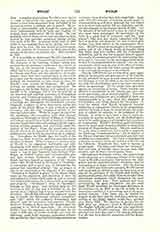

Wurzburg Abbeys. —The city of Wurzburg was the seat of four Benedictine abbeys, namely, the Holy Redeemer’s, or St. Kilian’s; St. Andrew’s, later known as St. Burchard’s; St. Stephen’s; and the Scotch Abbey of St. James.
Abbey of the Holy Redeemer (S. Salvatoris), also called after St. Kilian, who was buried there, was founded by St. Burchard, the first Bishop of Wurzburg, about 745. The monks had charge of the cathedral (Salvatormunster) and the cathedral school. The latter gained considerable renown. Probably owing to laxity in observance of the rule, Bishop Bernwelf of Wurzburg replaced the monks in 786 by canons who led a common life and were popularly styled Brothers of St. Kilian. The expelled monks, more than fifty in number, found a home at the Abbey of Neustadt on the Main, where Bishop Megingatid, who had resigned the See of Wurzburg, was abbot.
St. Andrew’s Abbey (afterwards St. Burchard’s) was founded by St. Burchard shortly after 748, and soon became famous for its monastic school. After a period of decline in the tenth century it was reformed in 988 by Bishop Hugo of Wurzburg, who rebuilt the church and the monastery and placed Arnold, a monk of Hirasu, as abbot over it. On October 14, 984, this bishop had transferred thither the body of St. Bur-chard, and from that time the monastery became known as St. Burchard’s Abbey. Church and monastery having been destroyed by fire about 1030, Abbot Wilemuth rebuilt both (1033-42), and in 1042 Bishop St. Bruno of Wurzburg dedicated the new church in presence of Emperor Henry III and six bishops. Yielding to the request of the monks, Pius II, in a Bull dated February 4, 1464, changed the abbey church into a collegiate church, and permitted the former monks to remain as canons.
St. Stephen’s Abbey, founded by Henry of Rothenburg, Bishop of Wurzburg, about 1013, for canons who followed the Rule of St. Chrodegang. In 1057 Bishop Adalbero replaced the canons by thirty Benedictine monks from Ansbach. After a short period of decline in the first half of the fifteenth century, the abbey joined the Bursfeld reform in 1459. After suffering another period of decline in the latter half of the sixteenth century, it continued in a flourishing condition until its secularization in 1803. Since then the abbey church and the monastery have been used as a Protestant parish church and school. The historian Ignaz Gropp (1695-1758) was a monk of St. Stephen’s. He wrote the history of several Franconian saints and monasteries, and edited “Collectio novissima scriptorum et rerum Wirceburgensium a saeculo XVI hactenus gestarum” (4 vols., Frankfort and Wurzburg, 1741-50).
St. James’s Abbey (St. Jakob zu den Schotten), founded as a Scotch monastery by Bishop Embrico of Wurzburg about 1134. Its first abbot was Bl. Macarius (1139-53) who with a few other monks had come from the Scotch monastery at Ratisbon. In 1146 he went to Rome to obtain relics and indulgences for his monastery. He died in 1153, and has always been honored as a saint. His feast is celebrated on January 24. The monks at St. James’s were all Irish or Scotch until 1497, when their number had dwindled down to one or two. The abbey was then given over to German monks, and in 1506 it was united to the Bursfeld Congregation. From 1506-16 the famous Johannes Trithemius (q.v.) was its abbot. In 1547 the whole monastery had died out, and its revenues went to the Bishop of Wurzburg. Upon the request of John Whyte, Abbot of the Scotch monastery at Ratisbon, it was again restored to the Scotch monks by Bishop Julius in 1595, and prospered for some time. Its last abbot, Placidus Hamilton, who, though very learned, lacked the qualities of a good ruler, resigned and retired to London in 1763. From that time till its secularization in 1803 it was ruled by priors. At its secularization it numbered eight monks The buildings are now used as a military hospital.
List of abbots: Macarius, 1139-53; Christian, 1153-79; Eugene, 1179-97; Gregory, 1197-1207; Matthew, 1207-15; Teclan, 1215-17; Elias I, 1217-23; Celestine, 1223-34; Gerard, 1234-42; John I, 1242-53; John II, 1253-74; Maurice I, 1274-98; Joel, 1298-1306; Elias II, 1306-18; John III, 1318-35; Michaeas, 1335-41; Rynaldus, 1342; Philip I, 1342-61; Donaldus, 1361-?, d. 1385; Henry, 1379; Maurice II, 1381?-88?; Timothy, 1388?-99; Imar, 1399-1409?; Rutger, 1409?-17; Thomas I, 1417-37; Roricus, 1437-47; Alanus, 1447-55; Maurice III, 1455-61; John IV, 1461-3; Otto, 1463-5; Thaddeus, 1465-74; David, 1474-83; Thomas II, 1483-94; Edmund, 1494-7; Philip II, 1497. These were followed by five German abbots: Kilian Crispus, 1504-6; Trithemius, 1506-16; Matthias, 1516-35; Erhard Jani, 1535-42; Michael Stephan, 1542-7. Since its restoration to the Scotch monks in 1595 the following were its abbots: Richard Irvin, 1595-8; John Whyte, at the same time Abbot of the Scotch monastery at Ratisbon, 1598-1602; Francis Hamilton, 1602-14; William Ogilbay, 1615-35; Robert Forbes, 1636-7; Audomarus Asloan, 1638-61; Maurus Dixon, 1661-79; Bernard Maxwell, 1679-85; Marianus Irvin, 1685-8; Ambrose Cook, 1689-1703; Augustine Bruce, who ruled as prior during 1703-13, and as abbot during 1713-16; Maurus Strachan, 1716-37; Augustine Duffus de Fochaber, 1739-53; Placidus Hamilton, 1756-63.
MICHAEL OTT

